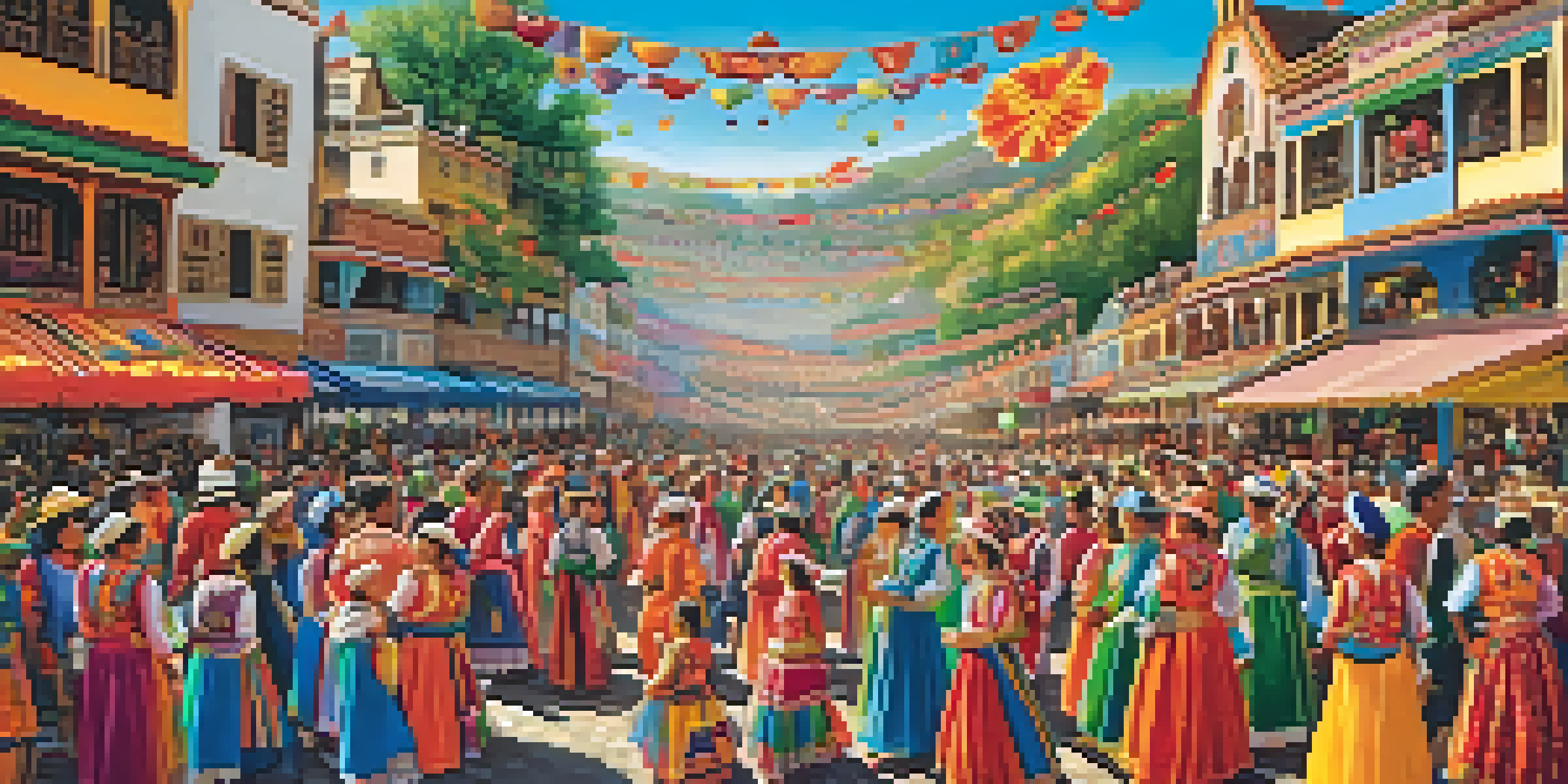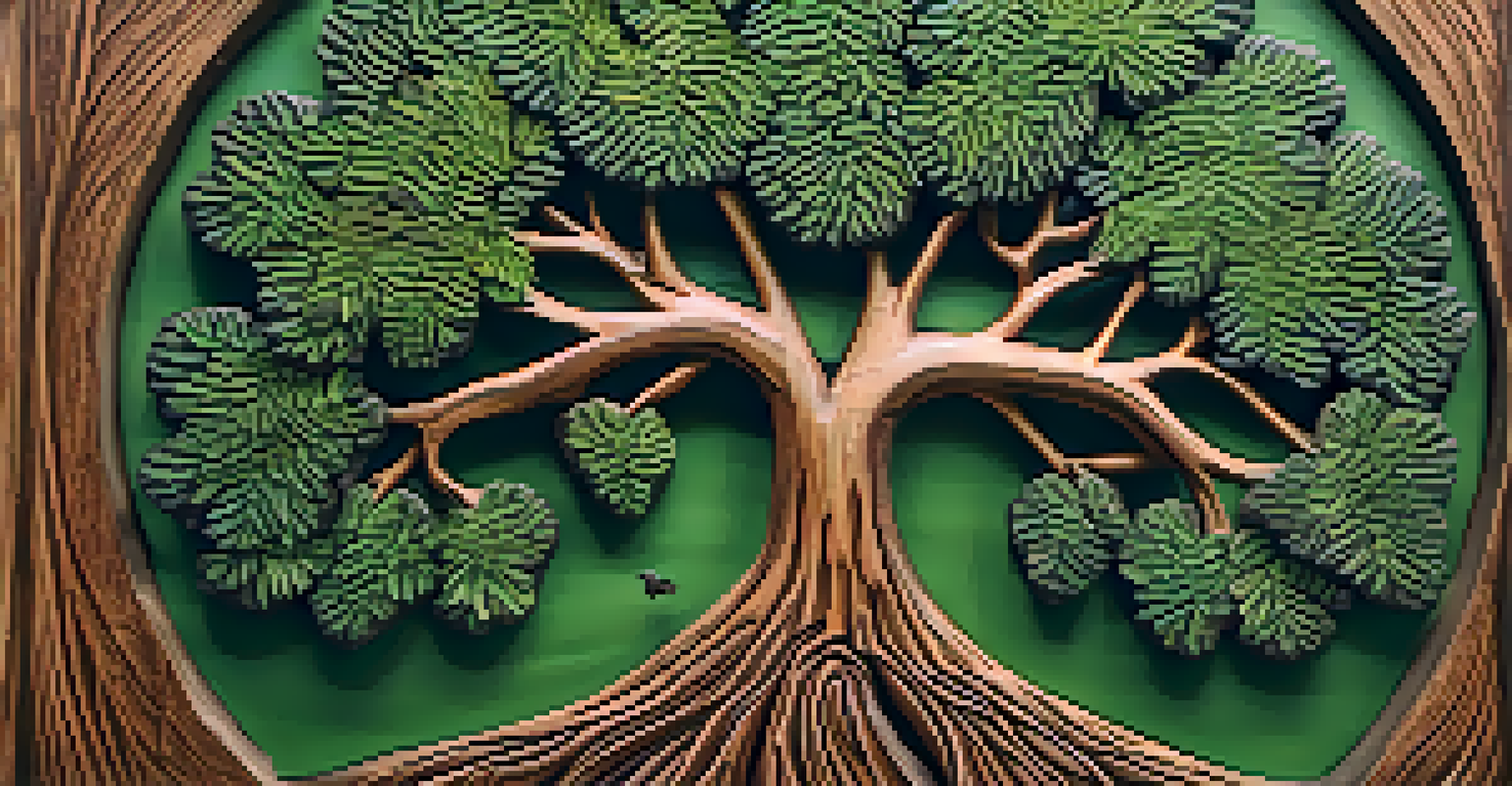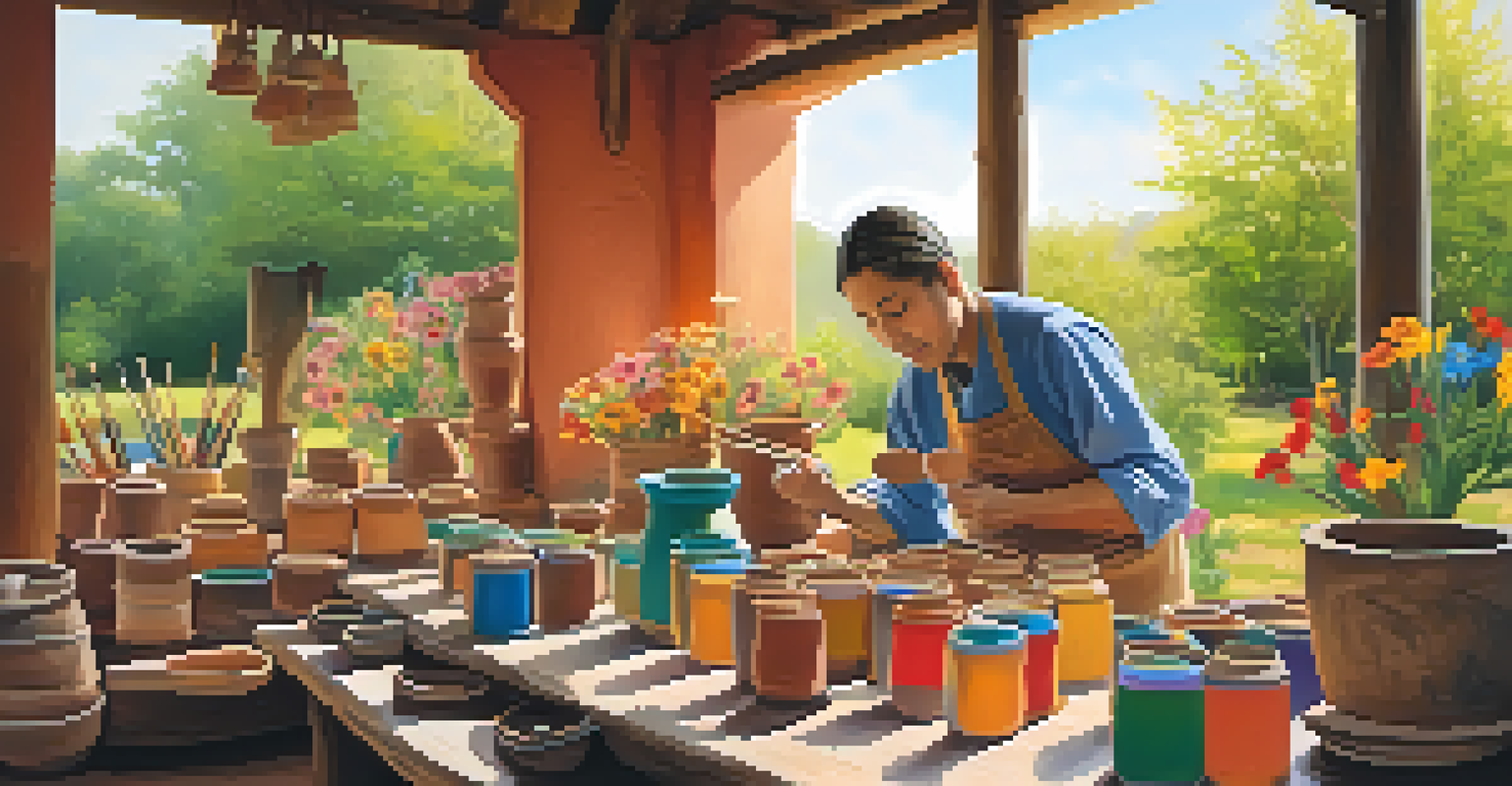Cultural Symbolism in Folk Art Painting Traditions

Understanding Folk Art: A Cultural Lens
Folk art serves as a vibrant reflection of the traditions and values of a community. It often incorporates local materials and techniques, making each piece unique to its cultural context. Through folk art, we gain insights into the history, beliefs, and daily life of the people who create it. This connection between art and culture is what makes folk art so compelling and significant.
Folk art is the creativity of the people, an expression of their identity and a celebration of their culture.
For instance, in many Indigenous cultures, art is not just an aesthetic pursuit but a way to tell stories and pass down knowledge. Each brushstroke or carving can convey deep meanings or historical events. This storytelling aspect of folk art helps to preserve cultural heritage and identity across generations, offering a visual language that transcends time.
As we delve deeper into folk art traditions, we uncover the layers of symbolism that enrich these creations. Each piece can serve as a window into the collective consciousness of a community, capturing their joys, struggles, and aspirations. Understanding this cultural lens is essential for appreciating the full beauty of folk art.
The Role of Symbols in Folk Art
Symbols are vital in folk art, as they often convey complex ideas and emotions in a simple visual format. These symbols can represent everything from nature and spirituality to social issues and personal narratives. For example, a tree might symbolize life or growth, while a bird could represent freedom or the spirit of the ancestors.

In many cultures, these symbols are deeply rooted in mythology and folklore. They carry meanings that may vary from one community to another, adding layers of richness to the artwork. For instance, the sun might symbolize warmth and fertility in one tradition, while in another, it could represent a deity or a source of power.
Folk Art Reflects Cultural Identity
Folk art serves as a vibrant reflection of community traditions, values, and shared narratives.
As we analyze various folk art pieces, it's fascinating to see how artists use symbols to communicate their cultural narratives. These visual shorthand methods create a dialogue between the artwork and its viewers, inviting interpretation and reflection. This interplay of symbolism not only enhances the artwork’s depth but also fosters a connection between diverse cultures.
Regional Variations in Folk Art Symbols
Folk art varies significantly across different regions, each with its own set of symbols that resonate with local beliefs and practices. For example, Mexican folk art often features vibrant colors and intricate designs that reflect indigenous and Spanish influences. Symbols like the skull in Día de los Muertos art serve to celebrate life and death in a unique cultural context.
Art is a way of survival. All art is a form of folk art.
Similarly, Scandinavian folk art has its own distinct motifs, such as rosemaling, which incorporates floral patterns and traditional colors. These symbols not only beautify everyday objects but also tell stories of the region's history and the people’s connection to nature. Each piece becomes a celebration of local identity and traditions.
Exploring these regional variations reveals how geography, history, and culture shape the symbols used in folk art. This diversity not only enriches the global tapestry of folk art but also highlights the importance of place in shaping artistic expression. Understanding these variations allows us to appreciate the broader cultural dialogues at play.
The Influence of Modernity on Folk Art
As the world becomes increasingly interconnected, modern influences are reshaping traditional folk art practices. Artists today often blend contemporary themes with traditional techniques, creating a fusion that speaks to both heritage and modernity. This evolution can lead to exciting new interpretations of classic symbols.
For instance, some artists might use traditional motifs to comment on current social issues, such as climate change or migration. By doing so, they ensure that folk art remains relevant and reflective of the times. This blending of old and new not only revitalizes folk art but also invites new audiences to engage with these traditions.
Symbols Convey Deep Meanings
Symbols in folk art communicate complex ideas and emotions, often rooted in local mythology and culture.
However, this modern influence can also raise questions about authenticity and cultural appropriation. It's essential for artists and consumers alike to navigate these conversations thoughtfully, ensuring that the essence of folk art is respected while also embracing its evolution. This balance is crucial in keeping folk art vibrant and meaningful.
Folk Art as a Tool for Cultural Preservation
Folk art plays a critical role in preserving cultural heritage, acting as a repository for community stories and traditions. In many cases, artists use their work to keep their culture alive, passing down knowledge and skills through generations. This practice not only honors the past but also instills a sense of pride in cultural identity.
For example, in regions where languages and oral traditions are fading, folk art can serve as a visual representation of that culture’s unique narrative. By showcasing traditional symbols and themes, artists can help keep cultural memory alive in a rapidly changing world. This aspect of folk art becomes increasingly important as globalization threatens to dilute local cultures.
Through exhibitions and community initiatives, folk art can reach wider audiences, fostering appreciation and understanding of different cultures. This outreach is essential for cultural preservation, as it invites dialogue and encourages respect for diverse traditions. In this way, folk art becomes not just a means of expression but also a vital tool for safeguarding cultural legacies.
Folk Art and Community Identity
Folk art is often a reflection of community identity, serving as a unifying force among its creators. Through shared symbols and themes, artists convey a collective narrative that strengthens community bonds. This sense of belonging is particularly evident in local festivals and gatherings, where folk art plays a central role in celebrations.
For instance, in many cultures, community events feature folk art exhibitions, showcasing the talents of local artists and celebrating cultural heritage. These gatherings not only promote the arts but also reinforce social ties, fostering a sense of pride in shared identity. As community members engage with folk art, they contribute to a dynamic cultural dialogue.
Modern Influences Shape Folk Art
Contemporary themes are blending with traditional techniques, ensuring folk art remains relevant and resonant.
Moreover, folk art can also serve as a platform for marginalized voices within a community. By highlighting unique perspectives and experiences, artists can challenge dominant narratives and promote social change. This ability to serve as a voice for the community underscores the profound impact of folk art on identity and social cohesion.
Conclusion: The Enduring Legacy of Folk Art
In conclusion, folk art is a rich tapestry woven from the threads of culture, history, and community. Its symbols carry profound meanings that reflect the values and beliefs of the people who create them. As we explore folk art painting traditions, we uncover a world where creativity meets cultural significance.
The ongoing evolution of folk art in the face of modern influences ensures that it remains a relevant form of expression. Whether through preserving traditions or adapting to contemporary themes, folk art continues to speak to the human experience. This dynamic nature is what keeps it alive and resonant across generations.

Ultimately, engaging with folk art allows us to appreciate the diverse stories that shape our world. By understanding the cultural symbolism embedded in these artworks, we gain valuable insights into the lives and identities of communities around the globe. This journey into folk art is a celebration of creativity and cultural heritage that invites us all to partake.